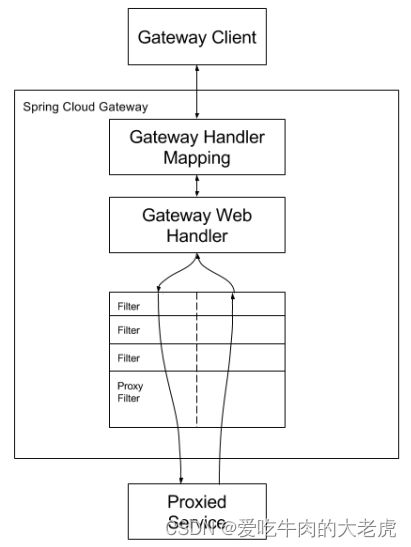SpringCloud之微服务API网关Gateway介绍
文章目录
- 1 微服务API网关Gateway
-
- 1.1 网关简介
- 1.2 Spring Cloud Gateway介绍
- 1.3 Gateway特性
- 1.4 Gateway核心概念
-
- 1.4.1 路由
-
- 1.4.1.1 定义
- 1.4.1.2 动态路由
- 1.4.2 断言
-
- 1.4.2.1 默认断言
- 1.4.2.2 自定义Predicate
- 1.4.3 过滤器
-
- 1.4.3.1 默认过滤器
- 1.4.3.2 自定义Filter(GatewayFilter)
- 1.4.3.2 自定义Filter(GlobalFilter)
- 1.4.3.3 自定义Filter(AbstractGatewayFilterFactory)
- 1.5 Gateway工作流程
- 1.6 实际操作
-
- 1.6.1 pom.xml
- 1.6.2 启动类
- 1.6.3 配置文件 application.yml
1 微服务API网关Gateway
1.1 网关简介
如果没有网关,难道不行吗?功能上是可以的,我们直接调用提供的接口就可以了。那为什么还需要网关?
因为网关的作用不仅仅是转发请求而已。我们可以试想一下,如果需要做一个请求认证功能,我们可以接入到 API 服务中。但是倘若后续又有服务需要接入,我们又需要重复接入。这样我们不仅代码要重复编写,而且后期也不利于维护。
由于接入网关后,网关将转发请求。所以在这一层做请求认证,天然合适。这样这需要编写一次代码,在这一层过滤完毕,再转发给下面的 API。所以 API 网关的通常作用是完成一些通用的功能,如请求认证,请求记录,请求限流,黑白名单判断等。
API网关是一个服务器,是系统的唯一入口。
API网关方式的核心要点是,所有的客户端和消费端都通过统一的网关接入微服务,在网关层处理所有的非业务功能。通常,网关提供REST/HTTP的访问API。
1.2 Spring Cloud Gateway介绍
Spring Cloud Gateway 是 Spring Cloud 的新一代API网关,基于WebFlux框架实现,它旨在为微服务架构提供一种简单而有效的统一的API路由管理方式。
Spring Cloud Gateway作为Spring Cloud生态系统中的网关,目标是替代Netflix ZUUL,具有更好的性能、更强的扩展性、以及更丰富的功能特性,其不仅提供统一的路由方式,并且基于Filter链的方式提供了网关基本的功能,例如:安全,监控/埋点,限流等。
1.3 Gateway特性
Spring Cloud Gateway特性:
- 基于Spring Framework 5, Project Reactor和Spring Boot 2.0
- 动态路由:能够匹配任何请求属性
- 可以对路由指定 Predicate 和 Filter
- 集成
Hystrix断路器 - 集成
Spring Cloud DiscoveryClient服务发现功能 - 易于编写的Predicate和Filter
- 请求限流
- 支持路径重写
1.4 Gateway核心概念
1.4.1 路由
1.4.1.1 定义
路由(Route)是网关最基础的部分,路由信息由一个ID,一个目标URI,一组断言和过滤器组成。路由断言Predicate用于匹配请求,过滤器 Filter 用于修改请求和响应。如果断言为true,则说明请求URI和配置匹配,则执行路由。
spring:
cloud:
gateway:
# 定义多个路由
routes:
# 一个路由route的id
- id: path_route
# 该路由转发的目标URI
uri: https://example.org
# 路由条件集合
predicates:
- Path=/test/**
# 过滤器集合
filters:
- AddRequestHeader=X-Request-Id, 1024
- AddRequestParameter=color, red
1.4.1.2 动态路由
网关接收外部请求,按照一定的规则,将请求转发给其他服务或者应用。如果站在服务调用的角度,网关就扮演着服务消费者的角色,此时,如果再来看看服务调用的目标URI配置,就会很自然的发现一个问题,服务提供者调用的地址是写死的,即网关没有动态的发现服务,这就涉及到了服务的自动发现问题,以及发现服务后,所涉及到的服务调用的负载均衡的问题。
可以通过Nacos或者Eureka注册中心动态发现服务,通过Ribbon进行服务调用的负载均衡。同样,Gateway也可以整合Nacos或者Eureka,Ribbon从而实现动态路由的功能。
想要使用动态路由的功能,首先要整合注册中心,这里以Nacos为例
pom依赖
<dependency>
<groupId>com.alibaba.cloudgroupId>
<artifactId>spring-cloud-starter-alibaba-nacos-discoveryartifactId>
dependency>
配置文件
spring:
application:
name: cloud-gateway
cloud:
nacos:
discovery:
server-addr: localhost:8848
gateway:
routes:
#路由的ID,没有固定规则但要求唯一,建议配合服务名
- id: config_route
#匹配后提供服务的路由地址, 这里lb之后,跟的是要调用的服务名称
uri: lb://nacos-provider-8002
# 断言,路径相匹配的条件
predicates:
- Path=/routeconfig/rest/**
此时,当id为config_route的路由规则匹配某个请求后,在调用该请求对应的服务时,就会从nacos注册中心自动发现服务,并在服务调用的时候实现负载均衡。
1.4.2 断言
断言(Predicate)参考Java8 中的断言 Predicate ,用于实现请求匹配逻辑,例如匹配路径、请求头、请求参数等。请求与断言匹配则执行该路由。
在Gateway中,有一些的内置Predicate Factory,有了这些Pridicate Factory,在运行时,Gateway 会自动根据需要创建其对应的 Pridicate 对象测试路由条件。
1.4.2.1 默认断言
Gateway提供的断言有:Path 路由断言,After 路由断言,Cookie 路由断言,Header 路由断言 ,Host 路由断言 ,Method 路由断言
Path 路由断言 Factory: 根据请求路径匹配的路由条件工厂
spring:
cloud:
gateway:
routes:
- id: path_route
uri: https://example.org
predicates:
# 如果可以匹配的PathPattern有多个,则每个路径模式以,分开
- Path=/red/{segment},/blue/{segment}
After 路由断言 Factory: 在指定日期时间之后发生的请求都将被匹配
spring:
cloud:
gateway:
routes:
- id: after_route
uri: https://example.org
predicates:
- After=2017-01-20T17:42:47.789-07:00[America/Denver]
Cookie 路由断言 Factory: Cookie 路由断言 Factory有两个参数,cookie名称和正则表达式。请求包含此cookie名称且正则表达式为真的将会被匹配。
spring:
cloud:
gateway:
routes:
- id: cookie_route
uri: https://example.org
predicates:
- Cookie=chocolate, ch.p
Header 路由断言 Factory: Header 路由断言 Factory有两个参数,header名称和正则表达式。请求包含此header名称且正则表达式为真的将会被匹配。
spring:
cloud:
gateway:
routes:
- id: header_route
uri: https://example.org
predicates:
- Header=X-Request-Id, \d+
Host 路由断言 Factory: Host 路由断言 Factory包括一个参数:host name列表。使用Ant路径匹配规则, . 作为分隔符。
spring:
cloud:
gateway:
routes:
- id: host_route
uri: https://example.org
predicates:
- Host=**.somehost.org,**.anotherhost.org
Method 路由断言 Factory: Method 路由断言 Factory只包含一个参数:需要匹配的HTTP请求方式
spring:
cloud:
gateway:
routes:
- id: method_route
uri: https://example.org
predicates:
- Method=GET
1.4.2.2 自定义Predicate
可以自定义Predicate来实现复杂的路由匹配规则
实现自定义 Predicate 工厂
通过HostRoutePredicateFactory创建Predicate进行路由判断
@Component
public class MyHostRoutePredicateFactory extends AbstractRoutePredicateFactory<MyHostRoutePredicateFactory.Config> {
public MyHostRoutePredicateFactory() {
// Config 类作为 Predicate 的配置参数类
super(Config.class);
}
public static class Config {
// 路由匹配规则
private String hostName;
public String getHostName() {
return hostName;
}
public void setHostName(String hostName) {
this.hostName = hostName;
}
}
// 生成一个 Predicate 实例
@Override
public Predicate<ServerWebExchange> apply(Config config) {
// 实现匹配逻辑
return exchange -> {
// 根据config实现匹配判断
String host = exchange.getRequest().getURI().getHost();
// 匹配配置中的域名
return host.equals(config.getHostName());
};
}
}
使用
RouteLocator locator = new RouteLocatorBuilder(router)
.routes()
.route("test_route", r -> r.path("/test")
.filters(f -> f.filter(new MyHostRoutePredicateFactory.Config("www.test.com")))
.uri("http://localhost:8080"))
.build();
1.4.3 过滤器
过滤器(Filter) 指的是Spring框架中GatewayFilter的实例,使用过滤器,可以在请求被路由前后对请求进行修改
1.4.3.1 默认过滤器
配置文件中添加过滤器 filters
filters:
- AddRequestHeader=name,zs #请求头添加name:zs
- AddRequestParameter=color,blue #请求参数添加color:blue
- AddResponseHeader=phone,973345344 #响应头添加phone:973345344
- PrefixPath=/mypath #添加路径前缀/mypath
- StripPrefix=n #删除路径前缀n个
Spring Cloud Gateway内置的多种过滤器类,例如:
AddRequestHeader GatewayFilter:在请求头中添加参数PrefixPath GatewayFilter:请求路径前缀Hystrix GatewayFilter:断路器RateLimit GatewayFilter:限流Retry GatewayFilter:重试
1.4.3.2 自定义Filter(GatewayFilter)
可以通过实现GatewayFilter和Ordered接口自定义Filter来实现请求处理逻辑:
@Component
public class TokenFilter implements GatewayFilter, Ordered {
@Override
public Mono<Void> filter(ServerWebExchange exchange, GatewayFilterChain chain) {
//请求处理逻辑
log.info("请求路径:"+ exchange.getRequest().getPath());
ServerHttpRequest request = exchange.getRequest();
MultiValueMap<String, HttpCookie> cookies = request.getCookies();
List<HttpCookie> tokens = cookies.get("access_token");
if (tokens == null || tokens.size() == 0) {
throw new RuntimeException("少了cookie!");
}
return chain.filter(exchange);
}
@Override
public int getOrder() {
return 0;
}
}
1.4.3.2 自定义Filter(GlobalFilter)
public class MyFilter implements GlobalFilter {
@Override
public Mono<Void> filter(ServerWebExchange exchange, GatewayFilterChain chain) {
ServerHttpRequest request = exchange.getRequest();
ServerHttpResponse response = exchange.getResponse();
return null;
}
}
1.4.3.3 自定义Filter(AbstractGatewayFilterFactory)
通过继承AbstractGatewayFilterFactory来实现
public class DemoGatewayFilterFactory extends AbstractGatewayFilterFactory<DemoGatewayFilterFactory.Config> {
@Override
public GatewayFilter apply(Config config) {
return null;
}
//Config 静态内部类,负责指定网关的参数
static class Config{
private String arg1;
}
}
注意:DemoGatewayFilterFactory 的命名方式:由Demo + GatewayFilterFactory组成,
其中Demo是自己起名字,GatewayFilterFactory是固定的。
范型中的Config是我们待会要用到的静态内部类,用于声明过滤器中传递的参数
在Spring Cloud Gateway中,自定义的过滤器会在全局过滤器链中生效,不需要显式配置在路由配置中。这是因为AbstractGatewayFilterFactory类已经实现了GatewayFilterFactory接口,并且通过Spring的自动装配机制将其注册到全局过滤器链中,并且可以在任何路由上生效。
需要注意的是,在全局过滤器链中的顺序是根据Spring Bean加载顺序决定的。可以通过设置@Order注解或实现Ordered接口来控制自定义过滤器在全局过滤器链中的顺序。
1.5 Gateway工作流程
客户端向 Spring Cloud Gateway发出请求,然后在Gateway Handler Mapping中找到与请求相匹配的路由,将其发送到 Gateway Web Handler。Handler再通过指定的过滤器链来对请求进行过滤处理,最后发送到我们实际的服务执行业务逻辑,然后返回。

过滤器链被虚线分隔,是因为过滤器既可以在转发请求前拦截请求,也可以在请求处理之后对响应进行拦截处理。
1.6 实际操作
1.6.1 pom.xml
<dependency>
<groupId>org.springframework.cloudgroupId>
<artifactId>spring-cloud-starter-gatewayartifactId>
dependency>
1.6.2 启动类
@SpringBootApplication
@EnableEurekaClient
public class GatewayApplication {
public static void main(String[] args) {
SpringApplication.run(GatewayApplication.class, args);
}
}
1.6.3 配置文件 application.yml
spring:
application:
name: cloud-gateway
cloud:
gateway:
routes:
# 路由的ID,没有固定规则但要求唯一,建议配合服务名
- id: config_route
# 匹配后提供服务的路由地址
uri: http://ityouknow.com
# 断言,路径相匹配的条件
predicates:
- Path=/routeconfig/rest/**
- id: header_route
uri: http://ityouknow.com
predicates:
- Header=X-Request-Id, \d+
参考连接:
https://mp.weixin.qq.com/s/LY66FPCajHkzXJUFlfSNYg
https://blog.csdn.net/h1774733219/article/details/124384527
https://blog.csdn.net/qq_46203643/article/details/127150590